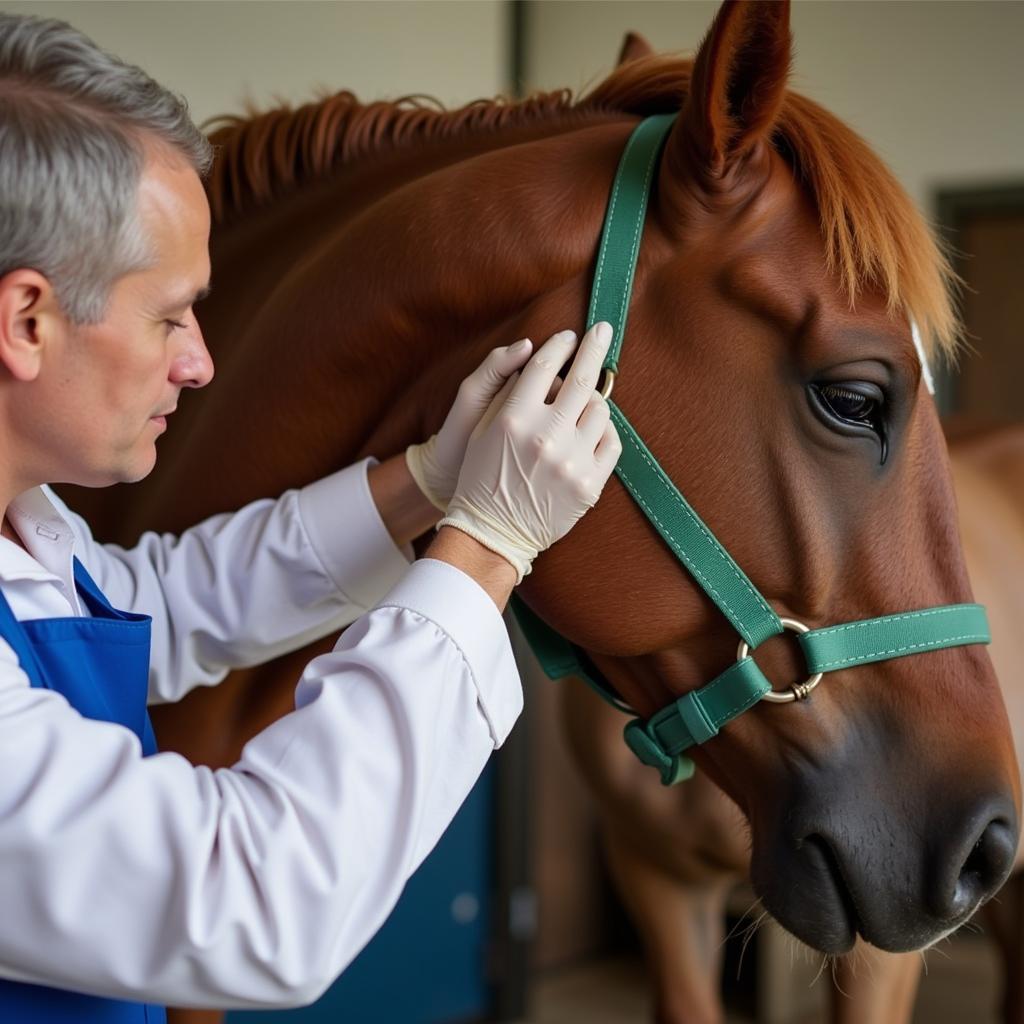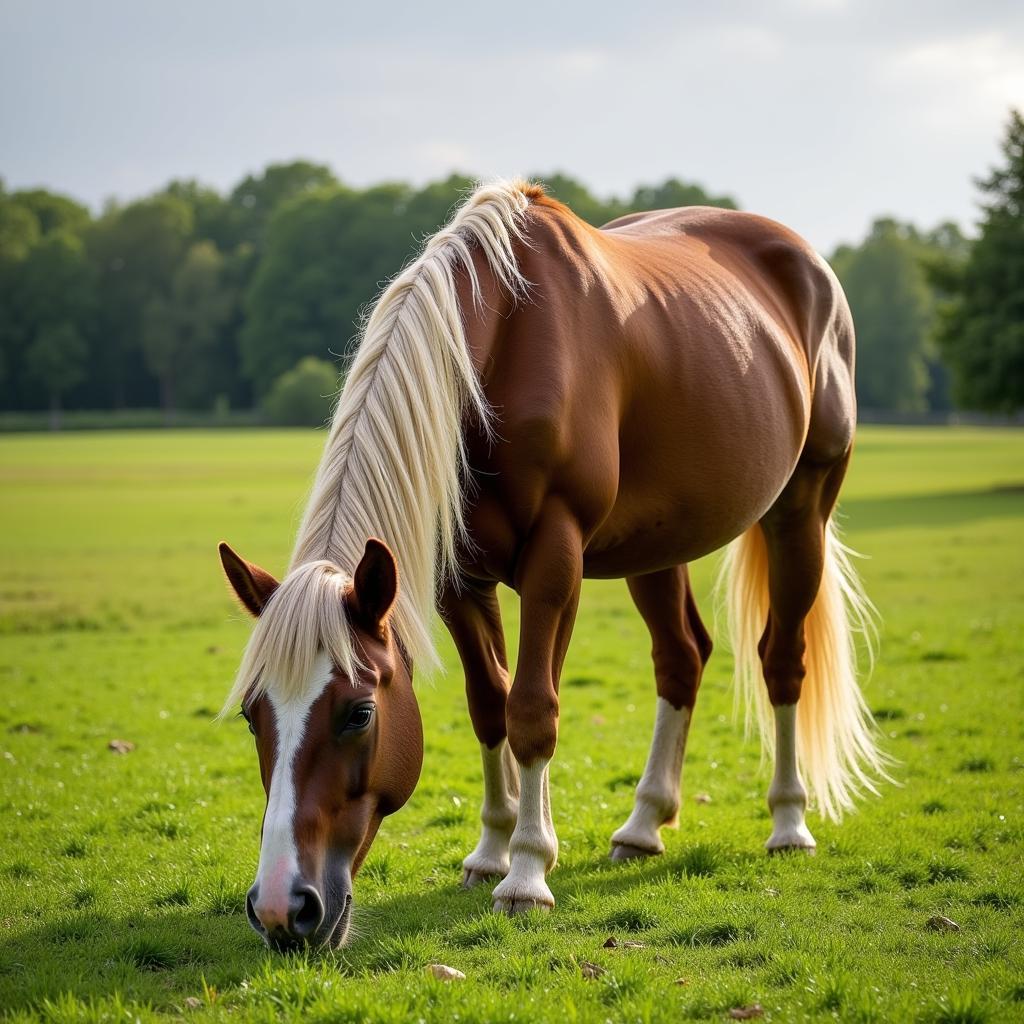Grass Mumps In Horses, also known as equine parotitis, is a relatively rare condition affecting the parotid glands, the largest salivary glands located just below the ears. It can cause swelling, discomfort, and difficulty eating. This article will delve into the causes, symptoms, diagnosis, and treatment of grass mumps in horses, providing you with the essential information you need to ensure your equine companion’s well-being.
What Causes Grass Mumps in Horses?
Several factors can contribute to the development of grass mumps in horses. While the exact cause isn’t always clear, it’s often associated with bacterial infections, particularly Streptococcus equi subspecies zooepidemicus. This bacteria can enter the parotid glands through the salivary ducts, leading to inflammation and swelling. Other potential causes include viral infections, guttural pouch infections, and even blockages within the salivary ducts themselves. Horses grazing on lush, rapidly growing pastures are sometimes more prone to grass mumps, possibly due to the high water content and potential for harboring bacteria in the grass.
 Swollen Parotid Gland in a Horse with Grass Mumps
Swollen Parotid Gland in a Horse with Grass Mumps
Recognizing the Symptoms of Grass Mumps
The most obvious symptom of grass mumps is swelling in the parotid gland region, typically appearing just below the ears. This swelling can be unilateral (affecting only one side) or bilateral (affecting both sides). The affected area might be warm to the touch and painful, causing the horse to show signs of discomfort when the area is touched. Other symptoms can include difficulty chewing or swallowing, excessive drooling, fever, and reduced appetite. If you notice any of these signs, it’s crucial to consult a veterinarian immediately. Early diagnosis and treatment are key to preventing potential complications.
Common Symptoms at a Glance
- Swelling below the ears
- Pain and warmth in the affected area
- Difficulty eating and swallowing
- Excessive drooling
- Fever
Diagnosing Grass Mumps in Horses
Diagnosing grass mumps typically involves a physical examination by a veterinarian. They will assess the swelling, check for pain and warmth, and evaluate the horse’s overall condition. In some cases, further diagnostic tests, such as blood work or a sample of saliva or pus from the affected gland, might be necessary to confirm the diagnosis and rule out other potential conditions. This can help identify the underlying cause of the inflammation and guide treatment decisions.
 Veterinarian Examining a Horse with Suspected Grass Mumps
Veterinarian Examining a Horse with Suspected Grass Mumps
Effective Treatment Options for Grass Mumps
Treatment for grass mumps focuses on addressing the underlying cause of the inflammation and managing the symptoms. If a bacterial infection is suspected, antibiotics are typically prescribed. Warm compresses applied to the affected area can help reduce swelling and discomfort. In some cases, flushing the salivary ducts might be necessary to remove any blockages or debris. Supportive care, such as ensuring the horse has access to fresh water and easily digestible food, is also essential for a speedy recovery.
“Early intervention is key in treating grass mumps,” says Dr. Emily Carter, DVM, an equine specialist with over 20 years of experience. “Prompt treatment can significantly reduce the risk of complications and help the horse return to normal activities quickly.”
Home Care Tips for Horses with Grass Mumps
- Offer soft, easily chewed feed
- Ensure access to fresh, clean water
- Apply warm compresses to the affected area as directed by your veterinarian
- Monitor the horse’s temperature and overall condition
Preventing Grass Mumps in Horses
While not always preventable, certain management practices can help reduce the risk of grass mumps. Maintaining good pasture hygiene, avoiding overcrowding, and ensuring horses have access to clean water sources can minimize the spread of bacteria. Regular dental checkups are also important, as dental issues can sometimes contribute to salivary gland problems.
 Healthy Horse Grazing on a Well-Maintained Pasture
Healthy Horse Grazing on a Well-Maintained Pasture
Conclusion
Grass mumps in horses can be a concerning condition, but with prompt diagnosis and appropriate treatment, most horses recover fully. Understanding the causes, symptoms, and treatment options is crucial for horse owners to ensure their animals receive the best possible care. By staying vigilant and working closely with your veterinarian, you can help protect your horse from this relatively uncommon but potentially problematic ailment. If you suspect your horse might have grass mumps, contact your veterinarian immediately. Early intervention is key to a successful outcome.
FAQ
-
Is grass mumps contagious? While not highly contagious, it’s possible for bacteria to spread between horses through shared water sources or contaminated equipment.
-
Can grass mumps recur? While less common, recurrence is possible, especially if the underlying cause isn’t fully addressed.
-
How long does it take for a horse to recover from grass mumps? Recovery time varies depending on the severity of the case and the individual horse, but most horses show improvement within a few days to a week with appropriate treatment.
-
Are certain breeds of horses more susceptible to grass mumps? There isn’t a known breed predisposition to grass mumps.
-
Can grass mumps affect a horse’s performance? Discomfort and difficulty eating can temporarily affect a horse’s performance, but most horses return to normal activity levels after recovery.
-
What are the potential complications of untreated grass mumps? Untreated grass mumps can potentially lead to abscess formation, chronic inflammation, or spread of infection to other areas.
-
Are there any natural remedies for grass mumps in horses? While some natural remedies might offer supportive care, it’s essential to consult a veterinarian for proper diagnosis and treatment.
Need more information? Check out our other articles on horse health and care: [Link to related articles on your website].
For any assistance, please contact us: Phone: 0772127271, Email: [email protected]. Or visit us at: QGM2+WX2, Vị Trung, Vị Thuỷ, Hậu Giang, Việt Nam. We have a 24/7 customer service team.